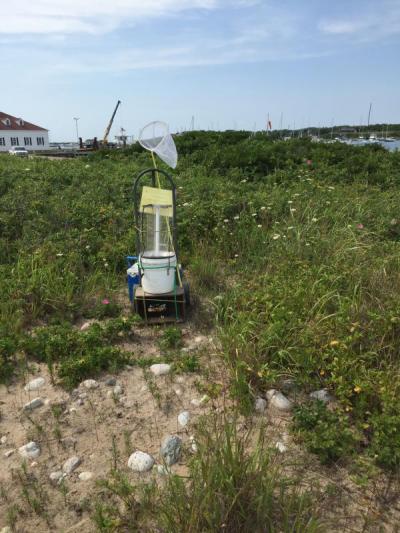2019 Cuttyhunk Survey highlights Elizabeth Island Moth Diversity by Jamie Bogart, Lloyd Center for the Environment Research Associate
Since 1988, the Lloyd Center for the Environment has ventured to the Elizabeth Islands to survey moths, setting UV light traps on the islands of Pasque, Naushon, Nashawena and Cuttyhunk. Between 1988 and 2015, the highest number of species by far was caught on Naushon (240) with the rest distributed between Pasque (88), Nashawena (36), and Cuttyhunk (24) islands.
In recent seasons (2016-2019), late-summer through early-fall (August-October) surveys were conducted on Cuttyhunk Island, which is easily accessible via the Cuttyhunk Ferry Company vessel, and has a rich variety of habitat which could easily contain more species than were detected thus far. Toward the island’s summit there are open and low shrubby areas, and low-lying areas that include wetlands, forested area, grassland, and barrier beach.
From 2016-2018, a light trap was set at the higher elevations near the lookout at one of two areas offering low shrubs, grasses, and various plants that attract moths. There were 57 detected species in 2016 (late-August and early-October surveys) alone, 40 species in 2017 (mid-September survey), and 16 species in 2018 (late-August survey). In addition, day surveys were conducted on the island for butterflies, which included species such as Wood Nymph, American Copper, Cloudless Sulfur, and Buckeye, to name a few, and caterpillars which were feeding on the Cherry trees. Wetlands containing the plant “Decadon” at the far end of the island toward the Gosnold Monument were searched for evidence of larvae of the Water-willow Stem Borer, a state-listed moth in Massachusetts, which was in fact confirmed on the island.
In 2019, the Lloyd Center returned to Cuttyhunk in late August during a season featuring a project on the mainland focusing on Lepidoptera associated with dune habitats. It made sense to set up a light trap on a beach area in an attempt to add to the diversity of moths documented on the island, and get a snapshot of the dune moth community in concert with this focus on “dune insect affiliates”. A long strip of beach which incidentally is protected for plovers and terns contains a mix of sand and dune-oriented vegetation which is optimum moth habitat.
From this one trap night 26 species were documented, including six that are new to Cuttyhunk, and three that are new to the Elizabeth Islands overall. Species new to the island included the “Coastal Heathland Cutworm” which thrives on open coastal habitats including dune areas and is listed as a species of Special Concern, and the “Pink Streak” which inhabits similar areas and is listed as Threatened. Both species are vulnerable to habitat loss.












